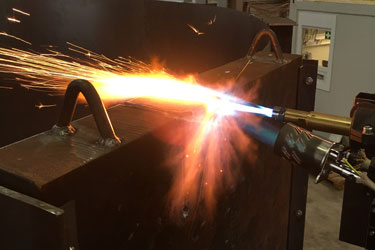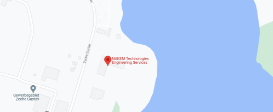
Alzenau, 22th October 2019. Before any machines and tools can be used for the actual dismantling of major components of a nuclear power plant, such as a reactor pressure vessel, they need first to be trialled at a full-sized test facility, known as a mock-up.
Since any repairs during the actual dismantling activities at a nuclear facility site can be risky, if not impossible, all of the working steps first undergo a thorough detailed check at a mock-up facility. During this ‘final rehearsal’ the functionality is tested and the process is optimized. Testing the equipment in a facility such as this, without radiation-related risks makes it possible to carry out such an optimization in a simplified way.
The tests follow the concept of parallel-working that will then be implemented under real-life conditions. For this, components are first pre-fragmented into large segments in their original positions, and afterwards these segments are further cut into small parts in a separate post-fragmentation room.
During the first stage of fragmentation, the reactor pressure vessel is cut by means of an autogenous flame cutting into rings with a height of up to 2.5m each, known as ‘barrel shells’. The tests are conducted on a model with a diameter of approximately 6m. Flue gases that are generated during the flame cutting process, are retained inside the pressure vessel by means of a contamination protection cover, these are then vacuumed off and filtered. The contamination protection cover also carries the guiding system for the autogenous flame-cutting unit, which makes it possible to perform the circumferential cut remotely. This way the entire reactor pressure vessel is gradually pre-fragmented from top to bottom.
The pre-cut rings are then fragmented into parts that are suitable for packaging in the main fragmentation room and brought to a short-term decay storage or final storage. All working operations in the main fragmentation room are performed remotely by means of an industrial robot. The adjustment of the control system to the individual cutting paths is also carried out at the mock-up using full-size models.
A thorough check of the equipment at the mock-up facility guarantees that when the equipment is used for the actual on-site dismantling activities, it is already free from any initial flaws, and the optimal process parameters are defined. This makes it possible to adhere to tight dismantling schedules by minimizing the risk of delays.
NUKEM Technologies in Karlstein am Main, Germany, is world-wide active in the areas of management of radioactive waste and spent fuel, decommissioning of nuclear facilities, engineering and consulting. For more than 60 years NUKEM Technologies provides high quality products, technologies and services, where Innovation, Solutions and Excellence are closely linked.
Contact:
Yvonne Amend
NUKEM Technologies Engineering Services GmbH
Zeche Gustav 6, 63791 Karlstein am Main
Tel: +49 6023 91-1321,
E-mail:
www.nukemtechnologies.de





